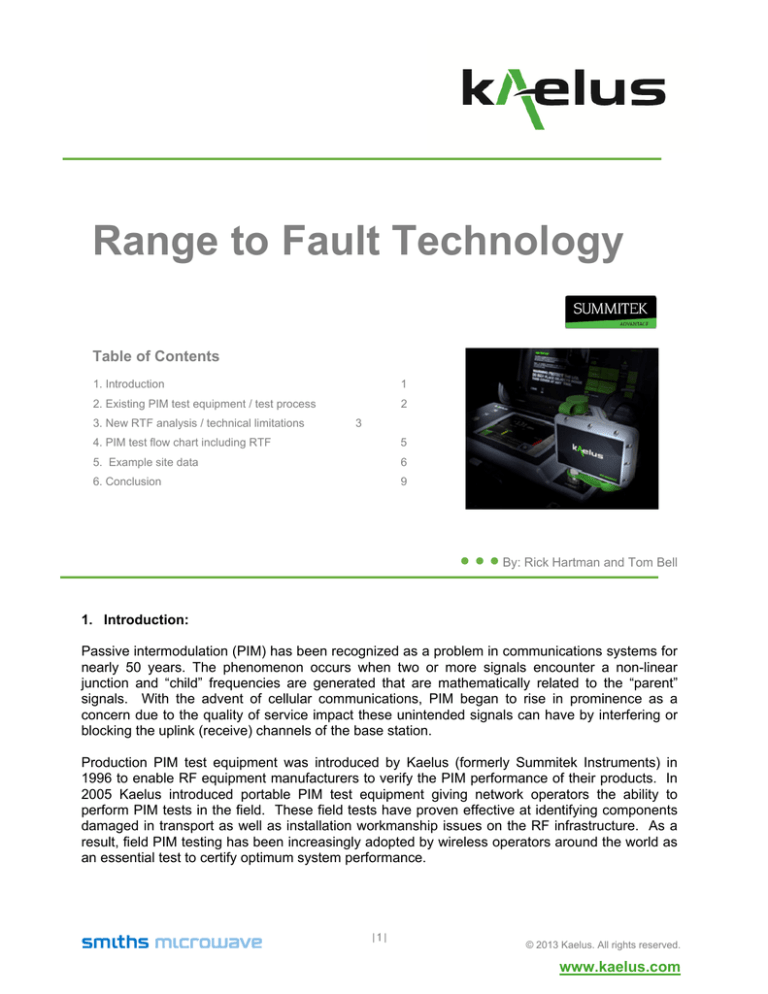
Range to Fault technology
Range to Fault Technology
Table of Contents
1. Introduction
1
2. Existing PIM test equipment / test process
2
3. New RTF analysis / technical limitations
3
4. PIM test flow chart including RTF
5
5. Example site data
6
6. Conclusion
9
By: Rick Hartman and Tom Bell
1. Introduction:
Passive intermodulation (PIM) has been recognized as a problem in communications systems for
nearly 50 years. The phenomenon occurs when two or more signals encounter a non-linear
junction and “child” frequencies are generated that are mathematically related to the “parent”
signals. With the advent of cellular communications, PIM began to rise in prominence as a
concern due to the quality of service impact these unintended signals can have by interfering or
blocking the uplink (receive) channels of the base station.
Production PIM test equipment was introduced by Kaelus (formerly Summitek Instruments) in
1996 to enable RF equipment manufacturers to verify the PIM performance of their products. In
2005 Kaelus introduced portable PIM test equipment giving network operators the ability to
perform PIM tests in the field. These field tests have proven effective at identifying components
damaged in transport as well as installation workmanship issues on the RF infrastructure. As a
result, field PIM testing has been increasingly adopted by wireless operators around the world as
an essential test to certify optimum system performance.
|1|
© 2013 Kaelus. All rights reserved.
www.kaelus.com
Range to Fault technology
PIM testing is different from traditional VSWR testing in that mechanical stimulus (tapping or
flexing) needs to be applied while testing to ensure a meaningful test. If the PIM spikes above a
threshold value during dynamic testing, the component or loose connection must be repaired or
replaced. In most cases determining the location of the PIM fault is relatively straight forward; the
fault is located where you are tapping.
Occasionally PIM faults will occur that do not produce large spikes in magnitude when
dynamically tested. Determining the location of these “non-responsive” or “static” PIM sources
becomes more challenging and can often be time consuming. To address this problem Kaelus
has developed Range to Fault (RTF) technology similar to that used in VSWR testing to help
identify the location of these static PIM sources. This paper discusses the capability and
limitations of this new technology as well a recommended test method for deploying RTF analysis
in the field.
2. Existing PIM test equipment / test process:
Passive Intermodulation test equipment transmits two 20W (+43dBm) test signals into the line or
device under test. If the test signals encounter a non-linear junction, mixing occurs causing the
PIM frequencies to be generated. The PIM test equipment measures the magnitude of the PIM
generated by the test signals and displays this information to the test operator.
The 3rd order product (IM3) is used to characterize PIM performance both in the factory and in the
field. The IM3 signal generated by a non-linear junction is usually higher magnitude than the
other PIM products enabling greater measurement accuracy. The higher order products (IM5,
IM7, IM9, etc.) typically fall off in magnitude by 5 to 10dB for each successive PIM product. By
controlling IM3 of the system to a specified level, the higher order products (which are more likely
to fall in the operators own Rx band) will be held well below the specified IM3 level.
The specific test frequencies used to excite PIM defects at a cell site are not critical as long as
the following criteria are met:
All RF components in the path (Cables, Antennas, TMA’s, etc.) must be able to pass the two
test frequencies and be able to pass the IM3 frequency you are measuring.
The two test frequencies must be within the operator’s licensed spectrum or be guard band
frequencies between licensed spectrum blocks to prevent interference with other operators.
|2|
© 2013 Kaelus. All rights reserved.
www.kaelus.com
Range to Fault technology
This applies to all system level tests where the test frequencies will be broadcast through the
antenna.
The two test frequencies need to be selected so that they will produce IM3 within the receive
band for that system. This will typically require test tones with wider frequency spacing than
can be achieved within the licensed frequency block for a given market. For this reason, at
least one guard band frequency will need to be selected.
During the PIM test all components and RF connections on the line should be subjected to
dynamic test conditions. If a component or RF connection generates unacceptable levels of PIM
when subjected to light mechanical stress it needs to be repaired. Passing a dynamic PIM test
ensures that the RF infrastructure is robust and will operate properly when exposed to normal
environmental stresses caused by wind and temperature extremes.
When testing a cell site it is recommended that a preliminary static PIM test be conducted to
evaluate the starting condition of the system. If the system passes the static test the operator will
proceed directly to dynamic testing. If the system fails the static test the operator should
disconnect the feed system from the antenna and install a low PIM load at the end of the line.
This method enables the test crew to isolate the feed system to resolve PIM problems
independently from the antenna and objects radiated by the antenna. Once the feed line passes
dynamic testing it can be re-connected to the antenna to verify system performance.
On some sites, particularly rooftop installations, the source of the PIM may be located beyond the
antenna. Since it is generally not the installation crew’s responsibility to resolve external PIM
sources, operators will generally accept the following three pieces of information as evidence that
the site was built according to specifications, even when the system PIM test fails:
1) Passing dynamic feed line test (into low PIM load)
2) Passing antenna test (antenna pointed at sky)
3) Failing system test when passing antenna and passing line are put together
3. New RTF analysis / technical limitations:
Range to Fault (RTF) technology from Kaelus is an analysis tool developed to enhance, not
replace, standard fixed tone PIM testing. The RTF solution includes the additional hardware and
signal processing software needed to transform frequency information into time domain plots
using inverse Fast Fourier Transform (FFT) and digital enhancement algorithms. RTF technology
is similar to the familiar Distance to Fault (DTF) function widely used at cell sites to identify VSWR
fault locations.
RTF works by transmitting two 20W (+43 dBm) test frequencies into the system under test. One
test frequency is fixed while the second frequency is swept over a range of frequencies to
produce IM products in the receive band of the system under test. Since RTF analysis requires
high power signals to be swept outside the operator’s licensed spectrum, this test should only
be conducted on systems that are terminated into a low PIM load to prevent interference.
The inverse FFT algorithm is used to reconstruct time domain range pulses by digitally summing
the quantized phase and amplitude components of each frequency involved in the computation.
|3|
© 2013 Kaelus. All rights reserved.
www.kaelus.com
Range to Fault technology
The more bandwidth available for analysis the sharper the mathematical pulse edges will be
providing improved resolution of closely spaced PIM sources.
Where resolution is defined as the distance between two equal amplitude pulses separated by a
6dB null, the resolution in meters which can be achieved using this analysis is expressed by the
following equation:
∆d = 150 vf / BW
Where: Δd = resolution in metres vf = velocity factor (fraction of speed of light) BW = PIM sweep bandwidth in MHz Using PCS spectrum as an example (Tx =1930–1990MHz and Rx = 1850–1910MHz) the
maximum IM3 sweep range that can be achieved in the PCS Rx band using two PCS Tx tones is
40MHz. This is achieved by holding one test frequency fixed at 1930MHz and sweeping the
other test frequency between 1950 and 1990MHz. This combination of frequencies will generate
IM3 products ranging from 1870 to 1910MHz in the PCS Rx band. Using this 40MHz of swept
IM3 bandwidth and a cable velocity factor of 0.88, the maximum resolution achievable using only
PCS spectrum is 3.3m. Kaelus has employed proprietary signal processing techniques to further
enhance resolution but the absolute accuracy of the prediction algorithm will suffer when multiple
PIM sources are located within the minimum resolution distance on the line.
The most effective way to use RTF analysis is to systematically remove the largest magnitude
PIM source identified on the line. Repeat the analysis and continue removing the largest PIM
source found until all significant static PIM sources have been removed. Regardless of its
location on the line, the distance to the largest PIM source will be predicted most accurately by
the algorithm. Each time a PIM source is repaired the accuracy for locating the next largest PIM
source will improve.
As initially stated, RTF analysis is not a replacement for dynamic PIM testing. RTF analysis will
enhance site testing and potentially speed the removal of static PIM sources at the cell site. The
analysis alone, however, should not be used to certify construction quality because;
Knowing the range to a fault provides a helpful starting point but does not ensure there are no
other hidden PIM sources within the RF feed system
The absolute value of the RTF PIM magnitude may not be accurate due to distortion brought
about by frequency sensitive group delay in RF devices such as surge arrestors, filters, TMAs
etc.
“Ghost” PIM sources can be created as a product of the mathematics and/or by impedance
mismatches in the system that reflect PIM generated at different locations on the line
The process flow chart shown in Section 4 illustrates the correct way to utilize RTF analysis when
PIM testing at a cell site. The cells highlighted in yellow represent the RTF test loop for removing
static PIM sources. The data presented in Section 5 shows actual measurements recorded while
following the flow chart to repair a system with multiple static and dynamic PIM problems on the
line.
4. PIM test flow chart including RTF analysis:
|4|
© 2013 Kaelus. All rights reserved.
www.kaelus.com
Range to Fault technology
|5|
© 2013 Kaelus. All rights reserved.
www.kaelus.com
Range to Fault technology
5. Example site data:
The following example shows actual test results from a feed line with multiple static and dynamic
PIM problems. The results not only show the benefit of RTF technology but also confirm the
importance of dynamic PIM testing at a cell site.
0 m ANTENNA
Line Configuration:
3 m 31 m 34 m TEST Step 1 – PIM test ‐ static, fixed tones: ‐79 dBm FAIL Step 2 – PIM test ‐ static, fixed tones: ‐80 dBm Low PIM load ANALYSIS Step 3 – RTF Analysis – Distance to largest PIM source = 3.08m (Repair) Step 4 – RTF Analysis – Distance to largest PIM source = 31.46m (Repair) Step 5 – RTF Analysis – No significant PIM sources found Step 6 – PIM test – static, fixed tones: ‐131 dBm TEST Step 7 – PIM test – dynamic, fixed tones: ‐68 dBm (Repair) Step 7 – PIM test – dynamic, fixed tones: ‐127 dBm Step 8 – PIM test – dynamic, fixed tones: ‐128 dBm PASS
Selected reports / screen shots:
|6|
© 2013 Kaelus. All rights reserved.
www.kaelus.com
Range to Fault technology
Distance to largest PIM source:
With an RTF Module attached the iQA user
software provides four different views the
operator can use to analyze PIM faults at
the cell site. The “Basic” view clearly
identifies the distance and magnitude of the
largest static PIM fault on the line. For
fastest
results,
Kaelus
recommends
methodically eliminating the largest PIM
fault and repeating until all static PIM
sources have been removed. Once the
static PIM sources are removed, the
operator can proceed to dynamic PIM
testing to certify that the PIM performance is
stable and robust.
PIM vs. Distance:
With a single button push, the operator
can switch to “PIM” view to see the
relative magnitude of all PIM sources
on the line. A marker function is
provided allowing the user to jump
from peak to peak displaying the
magnitude and distance to each PIM
fault. Kaelus’ RTF solution utilizes
proprietary
enhanced
resolution
algorithms that enable the user to
resolve closely spaced PIM faults that
a standard FFT analysis cannot see.
Return Loss vs. Distance:
With a second button push, the operator
can switch to “RL” view to see return loss
vs. distance. As with the PIM view, a marker
function is provided to display the
magnitude and distance of each Return
Loss peak.
PIM & Return Loss Overlay:
|7|
© 2013 Kaelus. All rights reserved.
www.kaelus.com
Range to Fault technology
“OVL” view overlays return loss vs.
distance and PIM vs. distance on a
single screen. The user can
independently set markers for both
PIM peaks and return loss peaks
and measure the relative distance
between faults. Electrically long
devices such as filters or TMAs,
and changes in velocity factor
caused by jumper cables vs.
feeders can reduce the absolute
accuracy of individual distance
calculations. Since these errors
impact both the PIM and return loss
calculations equally, the relative distance between faults is typically more accurate than the
individual distance calculations. Using the relative distance of a PIM problem to a known return
loss peak allows users to locate faults on the line with more precision than with PIM vs. distance
alone.
Dynamic PIM Test Results: (showing PIM problem not found by static PIM test or RTF analysis)
|8|
© 2013 Kaelus. All rights reserved.
www.kaelus.com
Range to Fault technology
6. Conclusion:
As demonstrated in the example above, RTF analysis can accurately predict the location of
multiple static PIM sources within the RF infrastructure. Armed with this information and following
the prescribed test procedure, PIM test crews should be able to repair sites more quickly and
reduce site to site repair time variability.
As also demonstrated in the example above, RTF analysis does not replace the need for dynamic
PIM testing of the RF feed system. RTF analysis will accurately predict the location of static PIM
sources that it can see but will not identify PIM sources that are only excited by mechanical
stress.
And finally, RTF analysis is a swept frequency test and should only be conducted on systems that
are terminated into a low PIM load. Testing into a load will prevent the broadcast of high power
test frequencies outside the operator’s licensed spectrum and eliminate the possibility of
interference.
Download the RTF datasheet for additional product and ordering information!
|9|
© 2013 Kaelus. All rights reserved.
www.kaelus.com
Range to Fault technology
Contact Us
Americas
+1.303.768.8080
Asia Pacific, Africa
+61.(0).7.3907.1200
China
+86.21.6084.2200
Europe, Middle East, India
+44.(0).1383.437920
www.kaelus.com
Rev_D_12.12 Follow @KaelusRF Online:
|10|
© 2013 Kaelus. All rights reserved.
www.kaelus.com



